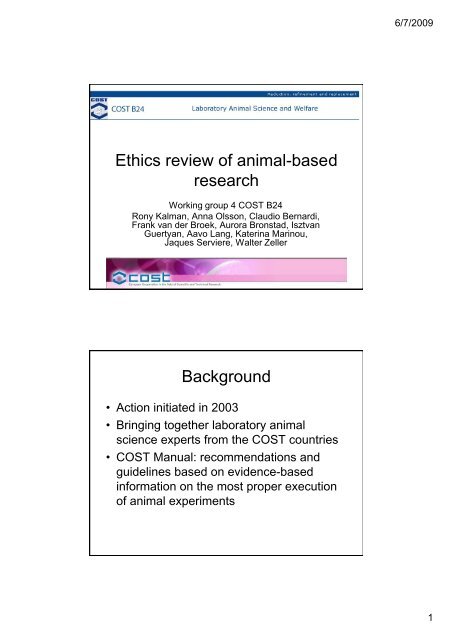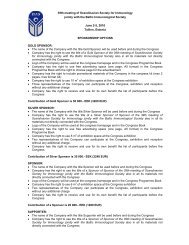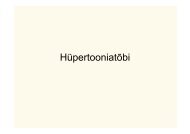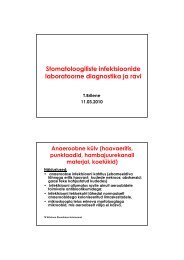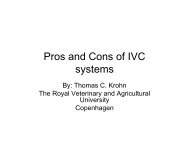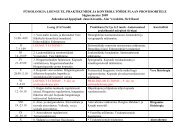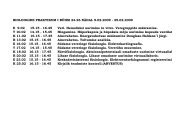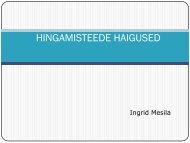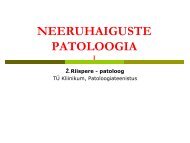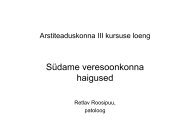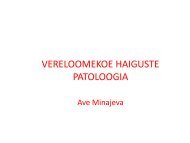Anna Olsson
Anna Olsson
Anna Olsson
You also want an ePaper? Increase the reach of your titles
YUMPU automatically turns print PDFs into web optimized ePapers that Google loves.
Ethics review of animal-based<br />
research<br />
Working group 4 COST B24<br />
Rony Kalman, <strong>Anna</strong> <strong>Olsson</strong>, Claudio Bernardi,<br />
Frank van der Broek, Aurora Bronstad, Isztvan<br />
Guertyan, Aavo Lang, Katerina Marinou,<br />
Jaques Serviere, Walter Zeller<br />
Background<br />
• Action initiated in 2003<br />
• Bringing together laboratory animal<br />
science experts from the COST countries<br />
• COST Manual: recommendations and<br />
guidelines based on evidence-based<br />
information on the most proper execution<br />
of animal experiments<br />
6/7/2009<br />
1
Ethics review - background<br />
• Most European countries have some kind<br />
of ethics review system in place<br />
• No reference to ethics review in Directive<br />
86/609/EEC<br />
• Unclear how ethics will be dealt with under<br />
revised Directive<br />
• ?Evidence ?Evidence-based ?Evidence based information?<br />
• Expert opinion + critical discussion<br />
Organization<br />
• Check-list of key issues to be addressed in<br />
a review<br />
– Tool for new committees (and new committee<br />
members) finding their way of working<br />
– Quality tool for crosschecking review work of<br />
existing committees<br />
• Discussion of potential and limitation for<br />
considering aspects<br />
6/7/2009<br />
2
Checklist for ethics reviews<br />
• Description and purpose of the study<br />
• Replacement<br />
• Refinement<br />
• Reduction<br />
• Competence<br />
• Other aspects<br />
– Composition of an ethics committee<br />
Ethics committee composition<br />
Minimum expertise<br />
• Scientists with knowledge and expertise in<br />
biological and biomedical research.<br />
• Veterinarian (preferably with qualifications<br />
in laboratory animal medicine)<br />
• A person without affiliation to the<br />
requesting organization<br />
6/7/2009<br />
3
Ethics committee composition<br />
Additional valuable expertise<br />
– Animal technician / caretaker<br />
– Animal protection organizations<br />
– Patient organization<br />
– Statistician<br />
– People with knowledge on alternatives to the<br />
use of animals<br />
– People with knowledge on animal welfare<br />
– Ethicist<br />
The ethics review<br />
Description and purpose of the study<br />
• Is there a description of the background<br />
and scientific reasoning of the general<br />
research and is the hypothesis to be<br />
tested specified?<br />
6/7/2009<br />
4
Replacement<br />
• Is there a precise statement clarifying<br />
why animals cannot be replaced by nonanimal<br />
approaches?<br />
• Is it clear that alternatives have been<br />
evaluated and which literature and<br />
databases have been consulted?<br />
Refinement<br />
• Is the origin of animals intended to be used in the<br />
experiments clear?<br />
– If not standard laboratory animal breeder, (i.e. animals from<br />
the wild), are methods for capture, restraint, identity marking<br />
and transport described and is the acclimatization period<br />
defined?<br />
– Do the animals have special needs (specific congenital<br />
conditions, altered immunological status etc.).<br />
• Is it clear how the animals will be prepared, handled<br />
and acclimatized prior to the experiment?<br />
• Are all experimental stages clear in terms of time scale<br />
and types of procedures involved (acclimatization<br />
phase, experimental phase, termination)?<br />
6/7/2009<br />
5
Refinement<br />
• Is there a clear protocol for anesthesia and pain<br />
control? Are doses, volumes, administration routes<br />
and frequency, and treatment duration reasonable for<br />
the species and actual procedure performed – and are<br />
they in accordance with relevant literature?<br />
• Are the Humane Endpoint (HEP) Criteria well defined<br />
and are the actions to be taken when reaching these<br />
criteria clear? Is it clearly identified who within the<br />
organization will be finally responsible to make the<br />
decision (attending veterinarian, scientists,<br />
management, other)?<br />
Refinement<br />
• Is there a list of techniques performed during<br />
the experiments? How will these techniques<br />
and the data collection influence the animals?<br />
• Are the follow up inspections with the animals<br />
described, and are they sufficient to identify<br />
potential complications in time?<br />
• Is method and time of euthanasia clearly<br />
defined? If there are any alternatives to<br />
euthanasia available (i.e. sanctuary for<br />
primates, return to herd for farm animals), are<br />
they specified?<br />
6/7/2009<br />
6
Refinement<br />
• Is there a description of housing and experimental<br />
conditions and enrichment for the animals?<br />
– If special housing conditions (i.e. metabolic cages, single<br />
housing) are requested for the experiment, are they<br />
described?<br />
– If special housing conditions (i.e. moist diet, extra bedding) are<br />
required to guarantee animal welfare, are they described?<br />
– Is the social housing adequate to the animal species and the<br />
research design described?<br />
– Do facilities fulfil all requirements necessary to carry out this<br />
study? (experimental areas, rooms for postoperative care,<br />
special condition for microbiological containment, etc.)<br />
• Has this experiment been evaluated and classified<br />
according to a severity classification system?<br />
Reduction<br />
• Has the committee been assured that only the optimal<br />
number of animals requested is being used in the<br />
study? Was a proper analysis performed on these<br />
aspects by a qualified person?<br />
• Has the potential conflict between the reduction of<br />
number of animals and fairness to the individual<br />
animal been considered in this experiment ?<br />
• Is the re-use of animals an option in this application? If<br />
yes, has the severity of the two experiments (previous<br />
one and the requested one) been taken into<br />
consideration?<br />
• Has the option of performing a limited pilot study been<br />
addressed by the researcher, and if this option was<br />
considered but not taken, was it justified?<br />
6/7/2009<br />
7
Competences<br />
• Is it clear who the principal researcher in the<br />
project is?<br />
• Are his or her qualifications and competence<br />
clear and sufficient?<br />
• It there a list of the other participants in the<br />
research group? Does the list include details<br />
on education and training of personnel<br />
involved in the procedures?<br />
• Has any experts been consulted during the<br />
study design and the preparation of the<br />
application (statistician, veterinarian, animal<br />
welfare officer, other)?<br />
Organization<br />
• Check-list of key issues to be addressed in<br />
a review<br />
• Discussion of potential and limitation<br />
for considering aspects<br />
6/7/2009<br />
8
Limited benefit as a reason to<br />
deny a license<br />
• Ethics review is often described (and<br />
possibly perceived by the public) as<br />
balancing animal harm against benefit to<br />
humans (and other animals)<br />
• Committees usually focus on the animal<br />
harm side<br />
• To fulfil their responsibility towards the<br />
public, committees should possibly<br />
address both<br />
Limited benefit as a reason to<br />
deny a license<br />
• Law rules out some uses: tobacco product<br />
development (UK), cosmetics (EU)<br />
• On the other hand, law also “rules in”<br />
uses: safety testing of products however<br />
futile these are perceived<br />
• Do committees really have remit to decide<br />
here?<br />
6/7/2009<br />
9
Replacement alternatives<br />
• Standard question - under present<br />
directive, llegal to use animals if nonanimal<br />
method exist<br />
• Replacement alternatives exist mainly for<br />
some standard procedures (toxicity) +<br />
teaching<br />
• Replacement in science generally means<br />
a change of approach – attitudes of<br />
scientists rather than ethics committee<br />
decisions<br />
Responsibility and authority:<br />
humane endpoints<br />
• HEP means that data collection from an<br />
animal stops when it has reached predefined<br />
clinical status<br />
• Potential conflict of interest between many<br />
involved:<br />
– Animal caretakers / technicians inspecting<br />
animal<br />
– Scientist running study<br />
– Veterinarian responsible for animal welfare in<br />
the facility<br />
6/7/2009<br />
10
Responsibility and authority:<br />
humane endpoints<br />
• Not applying HEPs when they should be<br />
applied means more suffering than<br />
necessary<br />
• Veterinary decision carries most weight<br />
(ETS123, 86/609/EEC)<br />
• Involving all personnel in planning to<br />
prevent conflicts<br />
• Ethics committee to handle conflicts adhoc<br />
Severity banding<br />
• Speed up procedure<br />
• Transparency<br />
• Severity: number or an equivalent term<br />
(e.g. “moderate”), with various and quite<br />
often obscure underlying algorithms of<br />
calculation<br />
• Making this procedure too automatic risks<br />
the quality<br />
6/7/2009<br />
11
Study design: the need for<br />
qualified personnel<br />
• Optimal number of animals – again a<br />
standard question<br />
• Power analysis or equivalent to estimate<br />
animal numbers<br />
• However dependent on specialized<br />
knowledge only a scientist from the field<br />
knows: variation, size of biologically<br />
relevant effect etc<br />
Study design: the need for<br />
qualified personnel<br />
• More efficient to educate the scientists and<br />
to require them to consult with statisticians<br />
than to try to cover this aspect in detail in<br />
the committee<br />
• It may still be useful for the committee to<br />
have a statistician linked to them to<br />
discuss protocols that seem weak or<br />
otherwise complicated<br />
6/7/2009<br />
12
Reduction and standardization<br />
• Standardizing to reduce number of<br />
animals<br />
• Narrowing down the range of conditions<br />
(sex, age, genotype) reduces the potential<br />
for extrapolation<br />
• Consider possible culling of animals if only<br />
one sex used<br />
Reduction and standardization<br />
• Narrowing down the range of conditions<br />
reduces the potential for extrapolation<br />
• Systematic variation rather than increased<br />
variation (e g several inbred strains rather<br />
than one outbred, several housing<br />
conditions)<br />
• Animal studies in general use too few<br />
animals – n for animal studies much<br />
smaller than the reduction in variation<br />
(compared to human clinical trials) justifies<br />
6/7/2009<br />
13
Reduction vs Refinement<br />
• Repetitive use of animals when not part of<br />
the same protocol<br />
• The benefit of Reduction compared with<br />
the additional cost in Refinement<br />
• The level of the total burden (including<br />
possible non-recovery from first<br />
intervention)<br />
• Total duration plus recovery interval<br />
Review of previous projects –<br />
harm evaluation<br />
• Information about animal welfare / animal<br />
harm in previous projects potentially very<br />
useful in hte evaluation of future projects<br />
using similar approaches<br />
• Information not found in existing literature<br />
• Committees with retrospective review<br />
process can do this internally<br />
• Central database for information transfer<br />
across committees<br />
6/7/2009<br />
14
Ensuring scientific validity<br />
• Scientific validity critical for ethical<br />
acceptability<br />
• Most committees do not address<br />
• Assumed ensured through funding<br />
• But not all work funded through peerreviewed<br />
applications<br />
• Funding application often not detailed<br />
enough<br />
Ensuring scientific validity<br />
• Concurrent scientific application<br />
(assuming ethics is evaluated by<br />
somebody else) and ethics application<br />
(assuming science is evaluated by<br />
somebody else) means harm is not<br />
weighed against benefits<br />
• Evaluation for funding should include<br />
overall ethics assessment<br />
• Ethics committee should evaluate details<br />
6/7/2009<br />
15
Communicating with the public<br />
• Transparency versus need to protect<br />
information (innovation and personal<br />
integrity concerns)<br />
• Freedom-of-information acts will enable<br />
access also to this information<br />
• Proactive – online publication of lay<br />
summaries<br />
Appropriate level of review<br />
• Project, experiment, procedure?<br />
• Different levels mean different focus and<br />
review possibilities<br />
• Project: replacement<br />
• Experiment: reduction<br />
• Procedure: refinement<br />
6/7/2009<br />
16
Appropriate level of review<br />
• The proposed checklist aims to include<br />
everything<br />
– Mission impossible?<br />
– Adminstrative burden for ethics committees – and<br />
scientists<br />
• Alternative: general review (on project level) +<br />
trust that institutions have mechanisms in place<br />
to ensure use of refined techniques, competent<br />
personnel etc<br />
The social role of the ethics review<br />
committee<br />
• ‘Culture of care’ – responsible use of<br />
animals<br />
• “Trust is good – control is better” – or?<br />
• Education<br />
• Discussion of ethical issues – internally<br />
and with the public<br />
6/7/2009<br />
17
• To the COST office<br />
for supporting this<br />
action and Timo<br />
Nevalainen for<br />
initiating it<br />
• To working group<br />
members<br />
Thanks<br />
• For your attention<br />
• olsson@ibmc.up.pt<br />
6/7/2009<br />
18


